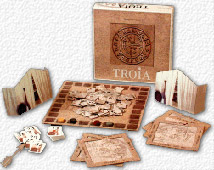
Publisher: DaimerChrysler
Author: Thomas Fackler
Tester: Aaron Haag
Game Tested: basic rules, published 2000
The Game: Two to four archeologists have the task to search for artifacts at an
excavation site in Troy. The site is represented by 64 tiles that are placed as one large
pile on the map board at the beginning of the game. Each tile is marked with a symbol
representing the (historical) layer to which it belongs and an indication of whether or
not it represents an artifact. Since all tiles are randomly oriented in the pile some lay
face up and other lay face down. While the layer symbol is printed on both sides the
artecact indicator is only printed on one side of a tile. Tiles on top will cover more or
less of the tiles at the bottom of the heap.
Each round players play cards simultaneously to indicate the action they want to perform
during their turn. They either can play an "excavate" card allowing them to
take up to 5 accessible tiles (i.e. tiles that are not covered by other tiles) from the
pile or explore up to 5 tiles (i.e. look at both sides of an already
excavated tile). A second type of cards allows a player to "publish" up to 5
explored tiles. Publishing is done by placing the tile(s) on the layer board representing
the layer where the tile was excavated (again indicated by the layer's symbol).
Points are awarded for such publications and the player with the highest points at the
end of the game wins. Normal tiles count one point, artifacts two points. A bonus of one
point per tile published in a turn is given to the player with the "largest"
publication, i.e. the publication that consists of more adjacent tiles than are already
placed on a layer board.
Playing Time: The game can easily be explained in 10 minutes and played in about 60 minutes.
Similar Games: Drunter & Drüber (Hans im Glück)
Westpark Gamer's Opinion: Typical for Thomas Fackler games the game components are very well designed but of not so exclusive materials than his more expensive games. The component design yields to the atmosphere of the game very nicely. However, playing the game is a completely different matter. Although players have basically a choice of different actions there is in fact hardly a situation where it is not downright clear what a player should do. After the first two to three rounds the layer boards have usually filled up so that much that it is very hard to get the bonus points for the largest publication. The luck element is quite high as it is out of the players control which tiles are accessible when its his or her turn let alone the fact that about half of the tiles on the pile are turned face down and not revealing if they are artifacts. One of the largest drawbacks of the game is, surprisingly, the component design itself. The location where a tile is placed on its layer board is indicated by thin lines representing the terrain profile. These lines are printed on both the tiles and the layer board in a very light grey color and show a rather complicated pattern. As a result, players spend quite some time in determining where their explored tiles will be published - far too much time in fact. The game is a not so difficult family game with quite an educational touch (it comes with a very well done booklet about the Troia site) but definitely not a game for the more serious type of gamer.
Aaron's Rating: 4 (out of 10)
Westpark Gamers Rating: 3.8
| Links to further information: | Board Game Geek Troia page |
| Funagain page with player reviews of Troia | |
| Luding link for Trioa |